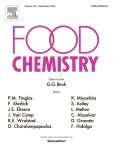Glycation and transglutaminase mediated glycosylation of fish gelatin peptides with glucosamine enhance bioactivity
Abstract
A mixture of novel glycopeptides from glycosylation between cold water fish skin gelatin hydrolysates and glucosamine (GlcN) via transglutaminase (TGase), as well as glycation between fish gelatin hydrolysate and GlcN were identified by their pattern of molecular distribution using MALDI-TOF-MS. Glycated/glycosylated hydrolysates showed superior bioactivity to their original hydrolysates. Alcalase-derived fish skin gelatin hydrolysate glycosylated with GlcN in the presence of TGase at 25 °C (FAT25) possessed antioxidant activity when tested in a linoleic acid oxidation system, when measured according to its 2,2-diphenyl-1-picrylhydrazyl (DPPH) scavenging activity and when tested at the cellular level with human hepatocarcinoma (HepG2) cells as target cells. In addition, Alcalase-derived glycosylated hydrolysates showed specificity toward the inhibition of Escherichia coli(E. coli). The Flavourzyme-derived glycopeptides prepared at 37 °C (FFC37 and FFT37) showed better DPPH scavenging activity than their native hydrolysates. The glycated Flavourzyme-derived hydrolysates were found to act as potential antimicrobial agents when incubated with E. coli and Bacillus subtilis.


Leave a Reply
You must be logged in to post a comment.